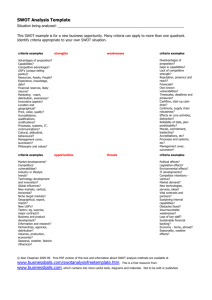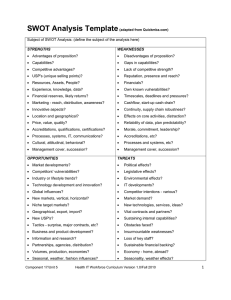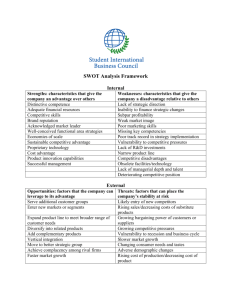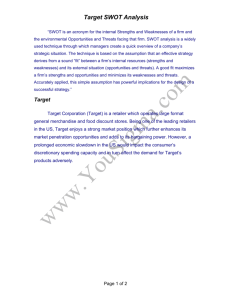SWOT Matrix
advertisement
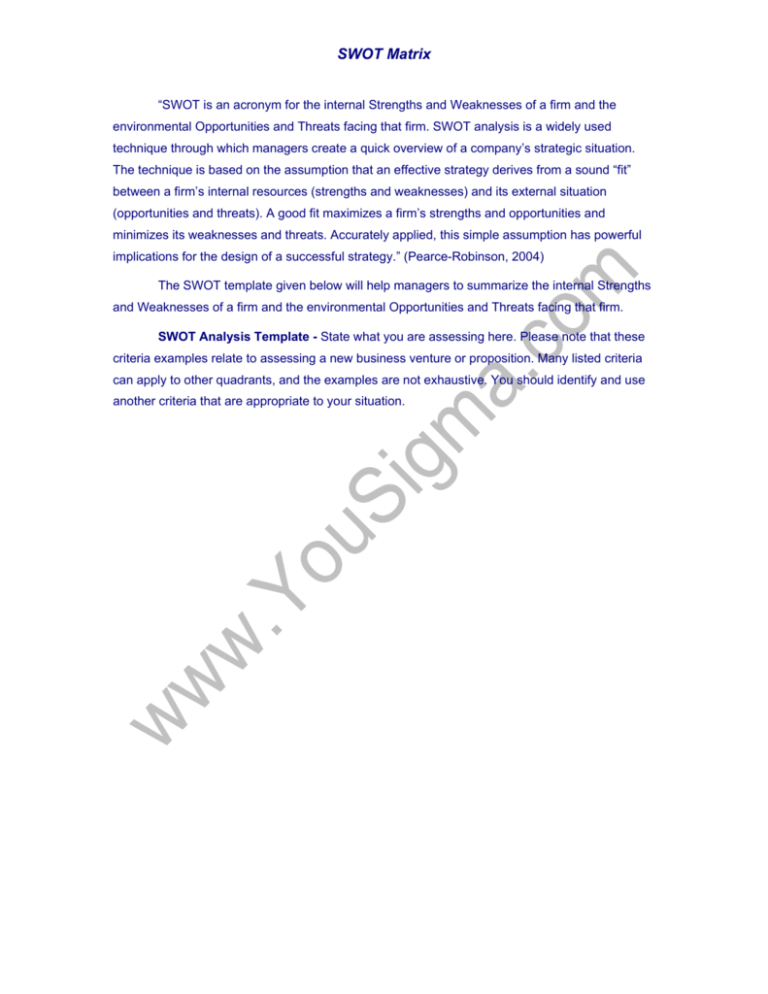
SWOT Matrix “SWOT is an acronym for the internal Strengths and Weaknesses of a firm and the environmental Opportunities and Threats facing that firm. SWOT analysis is a widely used technique through which managers create a quick overview of a company’s strategic situation. The technique is based on the assumption that an effective strategy derives from a sound “fit” between a firm’s internal resources (strengths and weaknesses) and its external situation (opportunities and threats). A good fit maximizes a firm’s strengths and opportunities and minimizes its weaknesses and threats. Accurately applied, this simple assumption has powerful implications for the design of a successful strategy.” (Pearce-Robinson, 2004) The SWOT template given below will help managers to summarize the internal Strengths and Weaknesses of a firm and the environmental Opportunities and Threats facing that firm. SWOT Analysis Template - State what you are assessing here. Please note that these criteria examples relate to assessing a new business venture or proposition. Many listed criteria can apply to other quadrants, and the examples are not exhaustive. You should identify and use another criteria that are appropriate to your situation. SWOT Matrix Strengths Weaknesses Criteria examples Criteria examples Advantages of proposition? Capabilities? Competitive advantages? USP's (unique selling points)? Resources, Assets, People? Experience, knowledge, data? Financial reserves, likely returns? Marketing - reach, distribution, awareness? Innovative aspects? Location and geographical? Price, value, quality? Accreditations, qualifications, certifications? Processes, systems, IT, communications? Cultural, attitudinal, behavioural? Management cover, succession? Philosophy and values? Disadvantages of proposition? Gaps in capabilities? Lack of competitive strength? Reputation, presence and reach? Financials? Own known vulnerabilities? Timescales, deadlines and pressures? Cashflow, start-up cash-drain? Continuity, supply chain robustness? Effects on core activities, distraction? Reliability of data, plan predictability? Morale, commitment, leadership? Accreditations, etc? Processes and systems, etc? Management cover, succession? SWOT Matrix Criteria examples Market developments? Competitors' vulnerabilities? Industry or lifestyle trends? Technology development and innovation? Global influences? New markets, vertical, horizontal? Niche target markets? Geographical, export, import? New USP's? Tactics: eg, surprise, major contracts? Business and product development? Information and research? Partnerships, agencies, distribution? Volumes, production, economies? Seasonal, weather, fashion influences? Opportunities Threats Criteria examples Political effects? Legislative effects? Environmental effects? IT developments? Competitor intentions various? Market demand? New technologies, services, ideas? Vital contracts and partners? Sustaining internal capabilities? Obstacles faced? Insurmountable weaknesses? Loss of key staff? Sustainable financial backing? Economy - home, abroad? Seasonality, weather effects? Represented are SWOT Analysis of Well Known Enterprises. The matrix was complied using internal information and market research data presented on Datamonitor, Bloomberg, and Business Insights. SWOT Matrix SWOT Analysis for SAP AG (January, 2008) SWOT Analysis for Washington Mutual, Inc. (February, 2008) Reference: Pearce-Robinson. (2004). Strategic Management. The McGraw−Hill Companies DATAMONITOR BUSINESS INFORMATION CENTER. (2007-2008). www.datamonitor.com Cite this as: YouSigma. (2008). "SWOT Matrix." From http://www.yousigma.com. Page 4 of 4

